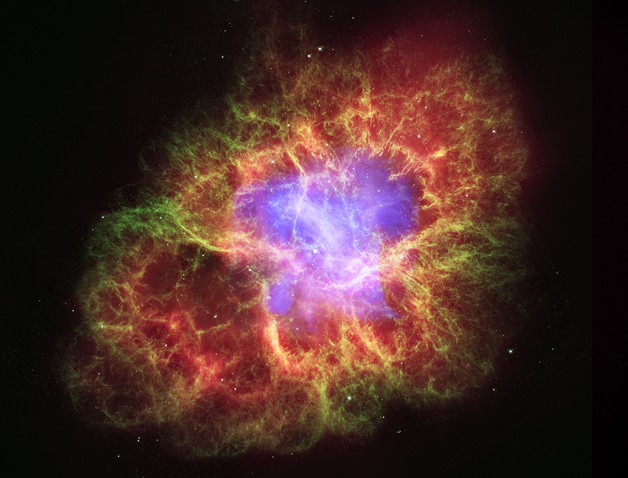• Title: Two Populations of X-ray Pulsars Produced by Two Types of Supernovae
• Authors: Christian Knigge, Malcolm Coe, Philipp Podsiadlowski
• First Author’s Institution: University of Southampton
The Theory
There are two types of supernovae believed to be capable of producing neutron stars:
1) Iron core-collapse supernovae. These supernovae occur when a high-mass star develops a degenerate iron core that is greater than the Chandrasekhar mass, a theoretical limit on the mass of a white dwarf. These supernovae tend to produce neutron stars of ~1.4 M☉, and they generally give the resulting neutron star a kick with an average velocity of >~200 km/s.
2) Electron-capture supernovae. These supernovae occur when a lower-mass core of oxygen, neon and magnesium suddenly captures electrons and loses pressure as a result. They only happen when a restrictive set of conditions are met, but these conditions are easier to meet in binary systems. These supernovae produce less-massive neutron stars of <~ 1.3 M☉, and the neutron stars end up with much smaller kicks of <~50 km/s.

Figure 1: Spin period vs. orbital period for neutron-star-hosting high-mass X-ray binaries. Filled circles are confirmed BeXs, open circles are candidate BeXs, and small dots are non-BeX systems. Blue = MW, red = SMC, black = LMC. Fig. 1 in the paper.
The Observation
Until now, there has been no observed evidence for these two formation channels in populations of neutron stars. In this paper, however, the authors present a study of a class of pulsar (a highly magnetized, rotating neutron star; see, for example, this astrobite) called Be/X-ray binaries, or BeXs. These are binary systems composed of a Be-type star (B star with strong hydrogen emission lines) and a neutron star that emits X-rays as a result of the rapid accretion of material from its companion. The authors study BeXs in the Milky Way (MW), the Small Magellanic Cloud (SMC), and the Large Magellanic Cloud (LMC), generating a total sample size of 66 systems.
Plotting the neutron star spin period vs the binary orbital period (Figure 1), the authors point out a correlation (albeit with high scatter) between the two parameters. Moreover, they demonstrate with histogram projections to the sides of the graph that there is an obvious bimodal distribution for both of these parameters — i.e., there are two distinct groups within this class of pulsars. The first sub-population has an orbital period of ~40 days and a spin period of ~10 seconds; the authors term this the short-period mode. The second sub-population has an orbital period of ~100 days and a spin period of ~200 seconds; this one is the long-period mode.

Figure 2: Histogram for the spin period of the various samples. Separate Gaussians are fitted to the two apparent subpopulations in each frame. Note that the bimodality is consistent across the different samples. Fig. 2 in the paper.
It’s interesting to note that this bimodality is the same in the MW, the SMC, and in the LMC (Figure 2), so it’s extremely unlikely that selection effects are responsible for this observed behavior.
The Implications
To avoid jumping to conclusions, the authors consider three possible explanations for this bimodal distribution in spin period:
1) This could correspond to two distinct neutron star equilibria, independent of the binary’s orbital state.
2) The orbital period could be time-dependent for BeXs, so the two sub-populations could correspond to two different evolutionary stages.
3) The two sub-populations represent two distinct BeX formation channels.
We can dismiss the first explanation due to the fact that the bimodality appears in orbital period as well. The second explanation is unlikely since the timescale for stellar-driven-wind changes in the orbital period is longer than the lifetime of the Be star producing the winds. Which leaves the third explanation, suggesting that the two pulsar populations could very well be produced by the two different types of supernovae that generate neutron stars!
Based on this explanation, we would expect the iron-core-collapse supernovae to generate systems with high-mass neutron stars that have long spin periods, long orbital periods, and high eccentricities, due to that extra-large kick. Electron-capture supernovae, on the other hand, would create systems with lower-mass neutron stars that have short spin periods, short orbital periods, and low eccentricities.
The authors caution that while the observation of the two different pulsar populations is robust, the explanation of the two formation channels is, of course, speculative. It does certainly seem to fit with the evidence, however, and could be confirmed with future studies that expand on the sample size. Another helpful confirmation would be pinning down the masses of the neutron stars in the systems, and the systems’ eccentricities, to see if they also correlate as predicted.




Trackbacks/Pingbacks